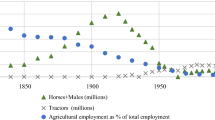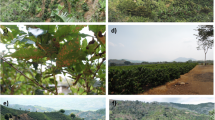Abstract
This study assesses the social, economic and environmental impacts and trade-offs of investment in tobacco in two districts in the Miombo woodlands of Malawi. Socioeconomic impacts were analyzed for stakeholder groups differentially affected by large-scale tobacco cultivation: those losing land to estates, those employed on estates, small-scale growers selling to the estates and small-scale wood suppliers. Tobacco growers emerge the biggest beneficiaries from the expansion of tobacco, with real returns among smallholders depending on the extent to which tobacco cultivation constricts or boosts other livelihood activities. Those losing land to tobacco estates are the major losers: efforts to recuperate their livelihoods prove less than adequate to offset the costs of land loss. Smallholder wood suppliers shared more or less the same outcome as employees in securing low returns, often inadequate for more than basic livelihood needs. The literature and fieldwork also document high rates of tobacco-induced deforestation from plantation expansion and unsustainable wood sourcing practices for tobacco drying and curing. Negative ecological externalities are born by local stakeholders and the public alike. We identify opportunities for leveraging more equitable and sustainable outcomes from land-based investments in forested landscapes.












Similar content being viewed by others
Notes
Usually on the pretext that these lands were “unutilized” (Chirwa 2004).
For instance Jaffee (2003) argues that the system was intended to protect the interests of commercial growers by precluding competition from the African smallholder sector rather than to ensure product quality.
The tobacco industry employs 12 % of the country’s workforce and generates a quarter of its tax earnings (Jomo and Seria 2010).
These include federal buy-outs of tobacco production in the U.S. and the lifting of price supports in both the EU and the US.
For instance, a tape measure was used to measure several stakes of wood described either as mendles or chords, with an average being derived for common usage. Through this preliminary standardization routine a chord was roughly equivalent to 2 mendles, which were equivalent to a standard ox-cart load, which was in turn equivalent to 2 cubic metres.
Due to the higher fertility and soil moisture.
The wood used to be more readily and cheaply available in the 1970s when the estate was established—with clearance of land for cultivation on adjacent farms and communal landholdings providing the major source of wood.
Interview with Dr James Munthali, Alliance One, October 2009.
Particularly the Forest Department and Agricultural Research and Extension Trust (ARET).
Group discussion with wood suppliers in villages under Chief Mavyere, in Mchinji—October 2009.
See also a recent WWF study, which found rampant illegal logging in Malawi’s protected areas—with Kasungu identified as one of the worst affected areas: ‘Uncertain future for Malawi’s forests’, available at: http://www.afrol.com/articles/19766 (accessed 28 July, 2010). See also: http://bushdrums.com/news/index.php?shownews=167.
Interveiw with Dr Henderson Chimoyo, Tobacco Control Commission, October 2009.
Interview with Dr Henderson Chimoyo, Tobacco Control Commission, October 2009. See also Africa News (2009), “High commodity pricing stalls Malawi exports”, available at: http://www.africanews.com/site/High_commodity_pricing_stalls_Malawi_exports/list_messages/28471 (accessed Jan 8, 2010).
E.g., groundnuts, Irish and sweet potatoes, cassava, tobacco, maize, millet and beans.
Green mealies, Irish and sweet potatoes, sugar cane and a variety of vegetable crops (e.g., tomato).
Such as through the specification of performance requirements (and accompanying indicators and public disclosure to enable monitoring and enforcement of the same) to impose certain obligations on foreign investments or investors.
References
Abalu, G., Mucavele, F., N'gon'gola, D., van Rooyen, J., Kirsten, J. F., Van Zyl, J., Saasa, O. S., Simbi, T., Sithole G., and Vink, N. (1996) Comparative Analysis of Structural Adjustment Programs in Southern Africa, with Emphasis on Agriculture and Trade. SD Publication Series Technical Paper 23. Nairobi: USAID/REDSO/ESA/ANR. Available at: http://www.afr-sd.org/publications/23souafr.pdf (accessed Oct 29, 2013).
Blomley, T., Pfliegner, K., Isango, J., Zahabu, E., Ahrends, A., and Burgess, N. (2008). Seeing the Wood for the Trees: An Assessment of the Impact of Participatory Forest Management on Forest Condition in Tanzania. Oryx 42(3): 380–391.
Borras, S. M., Franco, J. C., Carranza, D., and Alano, M. L. (2011). The Fundamentally Flawed ‘Marginal Lands’ Narrative: Insights from the Philippines. Paper presented at the International Conference on Global Land Grabbing, Brighton, UK, 6–8 April 2011.
Breag, C., and Harker, A. P. (1980). Tobacco. Report on a Visit to Malawi (6 February–13 April 1978) (Report 735). Tropical Products Institute, London.
Bunderson, W. T., and Hayes, I. M. (1997). Sustainable Tobacco Production in Malawi: The Role of Supply and Demand. Paper presented at the seminar on “Malawi Tobacco and the Future”, Club Makokola, Mangochi, October 1997.
Cavendish, W. (2002). Quantitative Methods for Estimating the Economic Value of Resource use to Rural Households. In Campbell, B. M., and Luckert, M. (eds.), Uncovering the Hidden Harvest: Valuation Methods for Woodland and Forest Resources. Earthscan, London, pp. 17–65.
Cernea, M. (2004). Impoverishment Risks, Risk Management, and Reconstruction: A Model of Population Displacement and Resettlement. Paper presented at the UN Symposium on Hydropower and Sustainable Development, Beijing, October 27–29, 2004. Available at: http://www.communitymining.org/attachments/254_population_resettlement_IRR_MODEL_cernea.pdf (accessed April 24, 2013).
Chifamba, O. and Chikwati, E. (2012). Zimbabwe: Tobacco curing and deforestation. Available at: http://allafrica.com/stories/201203160250.html?page=3 (accessed Oct 4, 2013).
Chilongo, T. (2005). An Assessment of Smallholders’ Access to Produce Markets in Malawi: The Case of Kasungu RDP. In Takane, T. (ed.), Current Issues in Rural Development in Malawi. IDE, Japan, pp. 141–164.
Chirwa, E. W. (2004). Access to Land, Growth and Poverty Reduction in Malawi. University of Malawi, Chancellor College.
Colchester, M. (2010). Free, Prior and Informed Consent: Making FPIC Work for Forests and Peoples. TFD Research Paper 11. The Forests Dialogue, New Haven.
Davoodi, H., and Zou, H. (1998). Fiscal Decentralization and Economic Growth: A Cross-Country Study. Journal of Urban Economics 43(1998): 244–257.
de Schutter, O. (2011). The Green Rush: The Global Race for Farmland and the Rights of Land Users. Harvard International Law Journal 52(2): 503–559.
FLEGT (2007). A Timber Legality Assurance System. FLEGT Briefing Notes 3. Available at: http://www.euflegt.efi.int/files/attachments/euflegt/efi_briefing_note_03_eng_221010.pdf (accessed April 24, 2013).
Fraser, A. I., and Bowles, R. C. D. (1986). The Use of Wood by the Tobacco Industry in Malawi. International Forestry Science Consultancy, Edinburgh.
Geist, H. (1997). How Tobacco Farming Contributes to Tropical Deforestation. Paper presented at the Tobacco Deliberation Group Meeting, National Committee for International Cooperation and Sustainable Development, Utrecht, 29 October 1997.
Geist, H. (1999). Global assessment of deforestation related to tobacco farming. Tobacco Control 8: 8–28.
Geist, H., Otanez, M., and Kapito, J. (2006). The Tobacco Industry in Malawi: A Globalized Driver of Local Land Change. In Lambin, E. F., and Giest, H. (eds.), Landuse and Land Cover Change: Local Processes and Globalized Impacts. Springer, Berlin, pp. 251–268.
German, L. (2011). Trade-Offs Associated with Large-Scale Land Acquisitions (in the Forest Frontier): Towards a Metric to Support Policy Decisions. Paper presented at the World Bank Conference on Land and Poverty, April 18–20, 2011.
German, L., Gumbo, D., and Schoneveld, G. (2013a). Large-Scale Investments in Chitemene Farmland: Exploring the Marginal Lands Narrative in Zambia’s Northern Province. QA-Rivista dell’Associazione Rossi-Doria 2(2013): 27p.
German, L., Schoneveld, G. C., and Mwangi, E. (2013b). Contemporary Processes of Large-Scale Land Acquisition in Sub-Saharan Africa: Legal Deficiency or Elite Capture of the Rule Of Law? World Development 48:1–18.
Gossage, S. J. (1997). Land Use on the Tobacco Estates of Malawi. Report of the Land Use Survey of Tobacco Estates in Malawi 1996. Estate Land Utilisation Study (ELUS), Lilongwe.
Government of Malawi (2002). Malawi National Land Policy. Ministry of Lands, Physical Planning and Survey, Lilongwe.
He, D., and Barr, C. (2004). China’s Pulp and Paper Sector: An Analysis of Supply–Demand and Medium Term Projections. International Forestry Review 6(3–4): 254–266.
ILC (2010). Commercial Pressures on Land Blog. International Land Coalition, Washington, D.C. Available at: http://www.landcoalition.org/cpl-blog (accessed Jan. 5, 2010).
Jaffee, S. (2003). Malawi’s Tobacco Sector: Standing on One Leg is Better Than None. Africa Region Working Paper Series 55. World Bank, Washington D.C.
Jomo, F., and Seria, N. (2010). Malawi to Boost Tobacco Export Earnings 20% as Quality Improves. Available at: http://www.businessweek.com/news/2010-03-31/malawi-to-boost-tobacco-export-earnings-20-as-quality-improves.html (accessed July 28, 2010).
Koester, U., Olney, G., Mataya, C., and Chidzanja, T. (2004) Status and Prospects of Malawi’s Tobacco Industry: A Value Chain Analysis. A report prepared for the Emergency Drought Recovery Project, Ministry of Agriculture, Lilongwe.
Maleta, M. (2004). Malawi – Tobacco Sector Performance Audit: Review of the Performance of Sector Institutions. Report Prepared for the Emergency Drought Recovery Project, Ministry of Agriculture, Lilongwe.
Matthews, A., and Wilshaw, C. (1992). Fodya: The Malawi Tobacco Handbook. Central Africana Limited, Blantyre.
Misana, S., Mung’ong’o, C., and Mukamuri, B. (1996). Miombo Woodlands in the Wider Context: Macroeconomic and Intersectoral Influences. In Campbell, B. (ed.), The Miombo in Transition: Woodlands and Welfare in Africa. Centre for International Forestry Research, Bogor.
Moyo, S., O’Keefe, P., and Sill, M. (1993). The Southern African Environment: Profiles of the SADC Countries. ETC Foundation/Earthscan Publishers Ltd., London.
Nsiku, N., and Botha, W. (2007). Tobacco Revenue Management: Malawi Case Study. International Institute for Sustainable Development, Winnipeg.
Ota, A. B. (2001). Reconstructing Livelihood of the Displaced Families in Development Projects: Causes of Failure and Room for Reconstruction. Paper presented at the conference, ‘Livelihoods and Poverty Reduction: Lessons from Eastern India’, 25–27 September 2001. Available at: http://www.anthrobase.com/Txt/O/Ota_A_02.htm (accessed April 24, 2013).
Otanez, M., Mamudu, H. M., and Glantz, S. A. (2009). Tobacco Companies’ Use of Developing Countries’ Economic Reliance on Tobacco to Lobby Against Global Tobacco Control: The Case of Malawi. American Journal of Public Health 99(10): 1759–1771.
Poitras, J. (1999). Malawi tobacco industry and the environment. Trade and the Environment Database Case Study 252. Available at: http://www1.american.edu/ted/maltobac.htm (accessed Oct 4, 2013).
Poulton, C., Kydd, J., and Kabame, D. (2007). Review of Experiences with Commercial Agriculture: Case Study on Malawi Tobacco. Centre for Environmental Policy, Imperial College, Kent.
Takane, T. (2005). Risky Business: Smallholder Tobacco Production and Rural Livelihoods in Malawi. In Takane, T. (ed.), Current Issues in Rural Development in Malawi. IDE, Japan, pp. 133–174.
Technoserve (2011). Outgrower Schemes—Enhancing Profitability. Technoserve Technical Brief. Technoserve, Washington, D.C.
Tobacco Control Commission (2004). Production Figure for Flue-Cured and Burley Tobacco, 1978–2004. Tobacco Control Commission, Lilongwe. Available at: http://www.tccmw.com/contact_us.htm (accessed Sept 14, 2012).
Tsonga, E. W. (2004) An Analysis of The Performance of Malawi’s Tobacco Production and Exports. A report prepared for the Emergency Drought Recovery Project, Ministry of Agriculture, Irrigation and Food Security, Lilongwe.
UNCTAD (2008). Identifying Core Elements in Investment Agreements in the APEC Region. UNCTAD Series on International Investment Policies for Development. United Nations, New York.
UNCTAD (2013). Global Value Chains and Development: Investment and Value Added Trade in the Global Economy. United Nations, New York.
Wilson, D., Wilson, K., and Harvey, C. (2011). Small Farmers, Big Change: Scaling Up Impact in Smallholder Agriculture. Oxfam, Oxford.
World Bank (1997). Causes and Consequences of Tropical Deforestation. Environmentally Sustainable Development Division, World Bank, Washington, D.C.
World Bank (2005). Pathways to Greater Efficiency and Growth in The Malawi Tobacco Industry: A Poverty and Social Impact Analysis. World Bank, Washington D.C.
Author information
Authors and Affiliations
Corresponding author
Rights and permissions
About this article
Cite this article
Mandondo, A., German, L., Utila, H. et al. Assessing Societal Benefits and Trade-Offs of Tobacco in the Miombo Woodlands of Malawi. Hum Ecol 42, 1–19 (2014). https://doi.org/10.1007/s10745-013-9620-x
Published:
Issue Date:
DOI: https://doi.org/10.1007/s10745-013-9620-x




